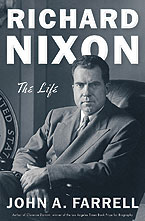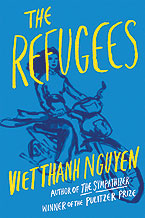 |
||||||||||||
|
March/April 2017 Nixon’s the One: Bio Reveals New Details of the Perfidy REVIEWS BY MARC LEEPSON
“Given the lies and human suffering at stake, and the internal discord that was ripping the United States apart,” Farrell writes in his illuminating book, “it is hard not to conclude that, of all of Richard Nixon’s actions in a lifetime of politics, this was the most reprehensible.” That reprehensible act had long been suspected. Most recently Ken Hughes’s Chasing Shadows: The Nixon Tapes, the Chennault Affair, and the Origins of Watergate, which we reviewed in the January/February 2015 issue, posited just that. But in this thoroughly researched, highly readable biography of the only U.S. president to resign from office, John Farrell has come up with a smoking gun—irrefutable evidence of Nixon playing politics that had deadly consequences for tens of thousands of Americans and Vietnamese. Farrell fastidiously and fairly examines Nixon’s life, beginning with his decision to run for Congress following his honorable service in the Navy in World War II. Farrell gracefully fills in Nixon’s back story as the book spools out details and analysis of Nixon’s public and private life up to his death in 1994. Along the way, there is a good deal about Nixon and the war in Vietnam, starting with his enthusiasm for John F. Kennedy’s policy of sending in large numbers of military advisers to help the South Vietnamese fight the Viet Cong in the early 1960s. Nixon became “a loud, insistent voice for escalation” during the Kennedy years, Farrell notes. He kept up those ultra-hawkish views about the war after Lyndon Johnson became president in 1963. Nixon also castigated doves who warned against escalating the war, and lambasted Johnson’s handling of the war, accusing him of not going all-out to defeat the Vietnamese communists. However, after the 1968 Tet Offensive, Nixon changed his mind. “I’ve come to the conclusion,” Nixon told Richard Whalen, one of his speechwriters, “there’s no way to win the war.” Nixon, who was running for the presidency that year, hid those thoughts from the public. “We can’t say that of course,” he said. “In fact, we have to seem to say the opposite, just to keep some degree of bargaining leverage: But the war can’t be brought to a successful military conclusion.” Then came Nixon’s shameful covert meddling in the peace process, which, Farrell says, “cost the United States an opportunity to end the war in the fall of 1968, saving tens of thousands of American and Vietnamese lives and four years of excruciating political division at home.” After taking office in January 1969, the Vietnam War was, in Haldeman’s words “the overriding factor” throughout Nixon’s first term. The war “overshadowed everything,” Haldeman said, “all the time, in every discussion, in every decision, in every opportunity and every problem.” During the ’68 campaign Nixon promised to bring “peace with honor,” but never said exactly how he would accomplish that. Farrell says that his plan simply was “to win.” But not in the conventional sense. The idea was to “wound and stay Hanoi long enough” for the South Vietnamese to gain the military strength to stand up to the North “and survive for at least a time on its own.” Meanwhile, Nixon chose to “mollify” the American public by ending the draft, withdrawing troops (“Vietnamization”), and reducing casualties. Nixon decided on what Farrell cleverly calls “a fighting retreat, ceding ground but not defeat. He would cling to the rearguard strategy for years, despite its costs.” Its costs were extremely high. There’s much more on Nixon’s prosecution of the war in this excellent book. Farrell covers the “Madman Theory,” in which Nixon tried to lead the North Vietnamese to believe he’d do any crazy thing to defeat them. Farrell writes concisely about the 1970 Cambodian incursion, Operation Lam Son, into Laos in 1971, the 1972 North Vietnamese Easter Offensive, the Operation Linebacker B-52 bombings, Secretary of State Henry Kissinger’s up-and-down negotiations to end the war, the POW issue, and Nixon and Kissinger’s dealings with the Soviets and the Chinese. And about the Nixon/Kissinger strategy of pulling out of South Vietnam after shoring up the Saigon regime just enough so it wouldn’t collapse right away—the “decent interval” scenario? Farrell calls it “a cynical abandonment of an ally that Nixon and his predecessors, time and again, had pledged to defend.” Although congressional funding cuts in 1973 have often been blamed for the 1975 collapse of South Vietnam, Farrell clearly shows that what ultimately happened in Vietnam rests squarely on Nixon and Kissinger’s shoulders. As top White House aide Gen. Alexander Haig put it: “I knew at the time [1973] that Vietnam was lost. I knew it, and I told it to Henry, and he knew it, and it was done by the president’s own people.”
The Refugees (Grove Press, 209 pp., $25), Viet Nguyen’s collection of excellent short stories, also brilliantly illuminates the inner lives of Vietnamese people as we read about them in eight well-crafted tales centered on refugees from the former South Vietnam (and their offspring) who wind up living in California. The stories include men and woman, young and old. “The Americans” is set in Vietnam as an embittered American veteran, a former B-52 pilot, and his Japanese wife visit their daughter who is teaching English to poor children in Quang Tri. As is the case with most of the stories in the book, “The Americans” is a sometimes-tense, poignant tale without a happy ending. It also contains elegant writing, including this passage describing the former pilot’s thoughts about his flying days. The man never found “himself freer than in the cockpit’s tight squeeze,” Viet Nguyen writes, “entrusted with a majestic machine carrying within its womb thirty tons of iron bombs, and yet for all that vulnerable as a Greek demigod.” Viet Thanh Nguyen—a University of Southern California history and American studies professor who came to this country as a child—peppers the stories with other insightful, clever passages, including this one in which he compares Liem, a young, present-day Vietnamese immigrant, to one of his sponsors, a man named Marcus Chan: “With body erect and head tilted back, Marcus had the posture of someone expecting an inheritance, while Liem’s sense of debt caused him to walk with eyes downcast, as if searching for pennies.” Later in the story, there’s this stunning passage as Liem stares pensively out the window of his sponsor’s house in San Francisco: “The light in the room had turned the window into a mirror, superimposing his likeness over the landscape outside. When he raised his hand, his reflection did the same, and when he traced the curve of his cheek and the line of his jaw, so, too, did the mirror image. Why, then, did he not recognize himself? And why did he see right through himself to the dark street outside?” |
||||||||||||
|
|
||||||||||||
|
||||||||||||
8719 Colesville Road, Suite 100, Silver Spring. MD 20910 | www.vva.org | contact us |
||||||||||||






















